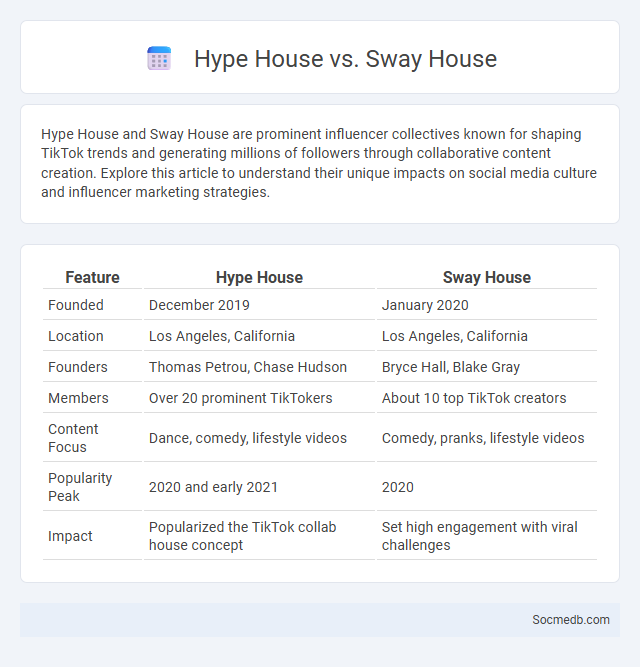
Photo illustration: Hype House vs Sway House
Hype House and Sway House are prominent influencer collectives known for shaping TikTok trends and generating millions of followers through collaborative content creation. Explore this article to understand their unique impacts on social media culture and influencer marketing strategies.
Table of Comparison
| Feature | Hype House | Sway House |
|---|---|---|
| Founded | December 2019 | January 2020 |
| Location | Los Angeles, California | Los Angeles, California |
| Founders | Thomas Petrou, Chase Hudson | Bryce Hall, Blake Gray |
| Members | Over 20 prominent TikTokers | About 10 top TikTok creators |
| Content Focus | Dance, comedy, lifestyle videos | Comedy, pranks, lifestyle videos |
| Popularity Peak | 2020 and early 2021 | 2020 |
| Impact | Popularized the TikTok collab house concept | Set high engagement with viral challenges |
Introduction: The Rise of Creator Collectives
Social media platforms have become powerful hubs where creator collectives thrive, transforming content creation into collaborative communities. These collectives leverage combined skills and audiences to amplify reach and engagement, making them pivotal in shaping digital trends and influencer marketing. Your participation in or support of a creator collective can increase visibility and foster innovative content strategies in the ever-evolving social media landscape.
What is Hype House?
Hype House is a Los Angeles-based collective of influential TikTok creators known for producing viral content and shaping trends on social media platforms. Founded in late 2019, it functions as a collaborative space where top young influencers live and work together to maximize audience engagement and brand partnerships. The group's popularity has significantly impacted digital marketing strategies by leveraging TikTok's algorithm and youth culture.
Exploring Sway House: Key Members and Content
Sway House is a prominent collective of influential social media creators known for their engaging TikTok and Instagram content. Key members like Bryce Hall, Noah Beck, and Josh Richards contribute diverse videos ranging from lifestyle and dance to comedy, attracting millions of followers. Your understanding of social media trends can deepen by exploring their collaborations and unique content styles that drive massive audience engagement.
Fan Base: The New Wave of Social Media Groups
Fan base communities have become the new wave of social media groups, transforming the way users interact and engage with content creators and brands. These targeted groups foster deeper connections by centering discussions around shared interests, passions, and fandoms, driving higher engagement rates and loyalty. Your participation in a dedicated fan base group enhances both the quality of interactions and the visibility of niche content.
Content Creation Styles: Battle of the Brands
Social media platforms showcase diverse content creation styles, where brands compete to capture audience attention through storytelling, visual design, and engagement tactics. Your brand's success depends on mastering formats like video, infographics, or interactive posts that resonate with target demographics and platform algorithms. Understanding this battle of the brands helps optimize content strategy to boost visibility, follower growth, and conversion rates.
Social Media Influence and Engagement Metrics
Social media influence is measured through key engagement metrics such as likes, shares, comments, and follower growth, which reflect the reach and impact of your content. Understanding these metrics helps you optimize your strategy by identifying what resonates with your audience and improving interaction rates. Monitoring engagement patterns enables you to enhance brand visibility and foster stronger connections within your digital community.
Business Models: Monetization Strategies Compared
Social media platforms employ various monetization strategies including advertising revenue, subscription models, and in-app purchases to generate income. Advertising remains the dominant business model, leveraging user data to offer targeted ads that increase conversion rates and maximize profit. Understanding these strategies helps your business choose the right platform to effectively engage audiences and optimize marketing budgets.
Major Controversies and Public Perceptions
Social media platforms frequently face major controversies involving misinformation, data privacy breaches, and algorithmic biases that affect user experience and trust. Public perception is often shaped by these issues, leading to calls for greater regulation and transparency from companies like Facebook, Twitter, and TikTok. Understanding these challenges helps you navigate social media more critically and protect your digital footprint.
Legacy and Future of Influencer Houses
Influencer houses have revolutionized content creation by fostering collaboration among top social media personalities, amplifying reach and engagement through shared resources and audiences. These digital hubs not only build lasting personal brands but also set trends that shape the future of influencer marketing by integrating emerging technologies like virtual reality and AI-driven analytics. You can leverage insights from these influential communities to stay ahead in the evolving landscape of social media content creation.
Conclusion: Who Reigns Supreme in Gen Z Culture?
TikTok dominates Gen Z culture by shaping trends, fostering viral challenges, and serving as a primary platform for authentic self-expression. Instagram maintains strong influence through visual storytelling and lifestyle branding, while Snapchat excels in private, ephemeral communication. Together, these platforms create a dynamic ecosystem where TikTok currently reigns supreme in defining Gen Z's social media landscape.
 socmedb.com
socmedb.com